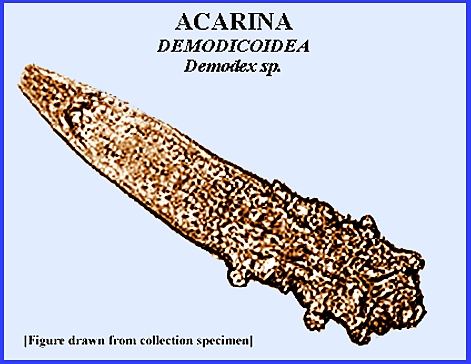File: <demodicoidea.htm> <Medical Index> <General Index> Site Description <Navigate to
Home>
|
DEMODICOIDEA (Hair-follicle Mites) (Contact) Please CLICK on
underlined links to view: These elongated,
worm-like mites have stump-like legs.
They are parasitic in the subaceous glands and hair follicles of
humans and animals. They have
modified piercing mouthparts. Members of the genus Demodes in the family Demodicidae attack humans. Demodex folliculorum
Simon is a hair follicle mite of humans.
Matheson (1950) reported that it lives in the hair follicles and
sebaceous glands where the life cycle is passed and infection can
spread. However, it of little
importance in spreading disease. Demodex canis Leydig infests dogs, causing mange, which is
difficult to control. Reports on this
mite attacking humans are not substantiated even given the close association
with dogs in households. OCCURRENCE Distribution
of these mites may be worldwide but they are rarely found in North
America. Other species in the genus
attack a variety of animals such as dogs and cattle, and are capable of
spreading disease. But they rarely
are found on humans and apparently incapable of spreading disease pathogens
if present. = = = = = = = = = = = = = = = = = = = = Key References: <medvet.ref.htm> [Additional references may be found at: MELVYL Library] Jarmuda,
Stanisław; Niamh O'Reilly, Ryszard Żaba, Oliwia Jakubowicz,
Andrej Szkaradkiewicz & Kevin Kavanagh.
2012.
"The potential role of Demodex folliculorum mites
and bacteria in the induction of rosacea". J. Med. Microbiol. 61: 1504–10. Lindsey,
Kristina, Sueko Matsumara, Elham Hatel & Esen K. Akpek. 2012.
Interventions for chronic blepharitis. Cochrane Database of Systematic Reviews 5: CD00556. Liu,
Jingbo; Sheha, Hosam; Tseng, Scheffer C. G. (October 2010). Pathogenic role of Demodex mites in
blepharitis. Current Opinion in Allergy & Clinical Immunology. 10
(5): 505–510. MacKenzie,
Debora. 2012. Rosacea may be caused by mite faeces in
your pores. New Scientist Aug 30. Matheson, R. 1950. Medical Entomology. Comstock Publ. Co, Inc. 610 p. Rufli,
T.; Mumcuoglu, Y. 1981. "The hair follicle mites Demodex folliculorum and Demodex brevis: biology
and medical importance. A review". Dermatologica 162 (1): 1–11. Rush,
Aisha. 2000. Demodex follicularum. Animal Diversity, Univ. of Michigan. Sengbusch,
H. G. & J. W. Hauswirth. 1986.
"Prevalence of hair follicle mites, Demodex folliculorum and D.
brevis (Acari: Demodicidae), in a selected human population in western
New York, USA". J. Medical Ent.
23 (4): 384–388. Service, M. 2008.
Medical Entomology For Students.
Cambridge Univ. Press. 289 p Thoemmes,
Megan S., Daniel J. Fergus, Julie Urban, Michelle Trautwein, Robert R. Dunn & Sergios-Orestis
Kolokotronis. 2014. "Ubiquity and Diversity of
Human-Associated Demodex
Mites". P L O S-One. 9 (8):
e106265. Urquhart,
G. M. (1996). Veterinary Parasitology (2nd
ed.). Blackwell Publ. Corp. Zhao,
Ya-e, Li Hu, Li-ping Wu &
Jun-xian Ma. 2012. A meta-analysis of association between acne ulgaris & Demodex
infestation. J.
Zhjiang Univ. Science
B. March. Zhao,
Ya-e, Yan Peng, Xiang-Ian Wang, Li-ping Wu, Mei Wang, Hu-ling Yan & Sheng-xiang Xiao. 2011.
Facial dermatosis associated with Demodex: a
case-control study. J. Zhejiang
Univ., Science B. 12 (8): 1008–1015 |
